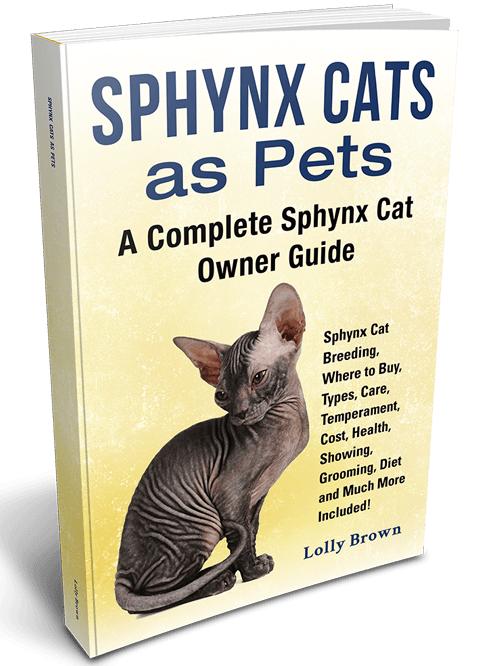CHAPTERS
Navigate to chapter
► Chapter 1: Understanding Sphynx Cats
► Chapter 2: Things to Know Before Getting a Sphynx Cat
► Chapter 3: Purchasing Your Sphynx Cat
► Chapter 4: Caring for Your New Sphynx
► Chapter 5: Meeting Your Sphynx Cat’s Nutritional Needs
► Chapter 6: Training Your Sphynx Cat
► Chapter 7: Grooming Your Sphynx Cat
► Chapter 8: Breeding Your Sphynx Cat
► Chapter 9: Showing Your Sphynx Cat
► Chapter 10: Keeping Your Cat Healthy
Chapter 1: Understanding Sphynx Cats

The Sphynx is a unique and wonderful bred of cat but it may not be the right choice for everyone. Before you decide whether or not it might be the right breed for you and your family, you need to learn as much as you can about these animals. In this chapter you will receive an introduction to the Sphynx cat breed including some basic facts and information as well as a history of the breed. This information, in combination with the practical information about keeping Sphynx cats in the next chapter, will help you decide if you should get one of these cats.
The word “sphynx” probably brings to mind images of ancient Egypt where gods walked the earth. The ancient Egyptians worshipped cats and the Sphynx cat breed is certainly one worthy of admiration. This breed of cat is known for its lack of coat but it is not actually completely hairless. Sphynx cats have a very fine layer of down-like fur on parts of their body and some of them even have a tuft of fur on the tips of their tail. The Sphynx cat’s skin itself is very soft, having a texture similar to that of chamois.
Not only does the Sphynx lack the typical cat coat, but it also may not have whiskers like a typical cat. Some Sphynx cats do have whiskers, though they are usually shorter or fewer in number than usual. Despite the fact that these cats do not have fur, they come in a wide variety of colors. The skin of the Sphynx cat may be any kind of solid or pattern including pointed colorations, tabby markings, tortoiseshell markings, or anything else you can imagine. They also come in a variety of colors including black, white, red, chocolate, lavender, and many more.
Another distinguishing characteristic that Sphynx cats have is wrinkled skin – it is particularly wrinkled around the head and neck. Sphynx cats have very large lemon-shaped eyes and large, broad ears that are pointed at the tip. Their overall size is usually between 6 and 12 pounds (2.7 to 5.4 kg) which is about average for a housecat.
Though the Sphynx cat might look strange, these cats have a number of redeeming qualities. Sphynx cats are one of the friendliest and most social breeds of cat – they love to cuddle with their owners and they are always seeking attention. Sphynx cats are very energetic and they love to play – they can even make friends with dogs and other household pets. If you work a full-time job or spend a lot of time away from home you would be wise to get another Sphynx cat or to give your cat some other form of companionship, be it human or animal.
Sphynx cats are sensitive to cold due to their lack of fur and they have a very fast metabolism that produce enough heat to make up for it. Like all cats, the Sphynx’s skin produces natural oils but because the cat doesn’t have fur to absorb the extra oil the Sphynx needs to be bathed several times a month to prevent buildup. In this way the Sphynx is a little more high-maintenance than the average housecat, even though he doesn’t have an actual coat that needs to be groomed.
In terms of health and wellness, the Sphynx is generally a healthy breed and it has an average lifespan between 8 and 14 years. The range for the Sphynx cat’s lifespan is so wide because there are a few hereditary conditions to which the breed is prone – this is also why responsible breeding is absolutely essential for this breed. Some of the conditions to which the Sphynx breed is prone include a skin condition called urticaria pigmentosa, a genetic condition called hypertrophic cardiomyopathy, and a heart problem called mitral valve dysplasia.
Pedigree: result of natural genetic mutation in a domestic cat with a regular coat
Breed Size: normal
Weight: average 6 to 12 pounds
Body Type: medium-boned, well-muscled
Coat Length: very short where present, peach-like fuzz
Skin Texture: wrinkled but soft, similar to chamois
Color: wide variety of colors and patterns
Eyes: eyes are large and lemon-shaped, slanting up at the corners
Ears: very large (2 to 3 inches tall), wide at the base
Tail: long, whip-like; sometimes has a tuft of hair on the tip
Temperament: very friendly and social, lively and active, devoted and loyal
Continue Reading…
Want to read the entire thing?

